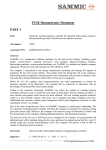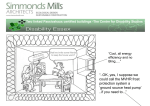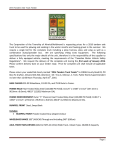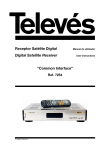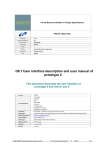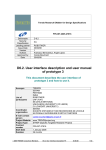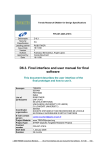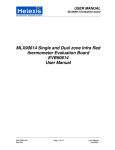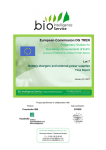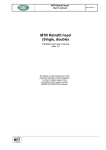Download Case Study
Transcript
FUSE Demonstrator Document PART I Title: Stirrup Bending Machine Controller. Microprocessor technology achieves a reliable control system and 40% costs reduction. AE number: 29826 Associated TTN: ROBOTIKER (COTEC) Abstract: ALBA, Maquinaria para la Construcción, S.A. manufactures different cutting and bending tools and machines for construction or building sector since 1.953. ALBA is a medium size Spanish company employing 98 persons, and achieved sales of 20.5 MECU in 1.999. The company is specialising in the design, manufacture, marketing and through life support of bending equipment for construction sector. The product improved during this AE is the company’s Stirrup Bending Machine used to produce reinforcing bars or stirrups, for construction. This machine operates by the controlled bending and cutting of coiled bar/rod in order to produce different types of stirrups. Before the AE, the company used a specifically developed control device to control their bending machines. A small Spanish engineering company supplies this control device. The experience of the company of microelectronic was that related with the installation and use of this control device. The company had no experience of electronics specification and design areas. The old control device generated a lot of problems and limitations with important maintenance costs of the equipment and important losses to the company. A new improved control device overcoming the faults and technical limitations of the old one has been developed during this AE. The use of the new microprocessor based control system also provides competitive advantages through cost reductions, reliability growth and machine performance improvement. The development of this new product and the close participation of the company also assures a complete control of the new product development in order to provide the required after sales support. Such support would be difficult unless the company is able to understand, modify and maintain the implemented new control system. The total cost of the AE was 57 KECU and it was completed in 11 months. With the new developed control system a 40% of reduction of the costs have been achieved. Our strategy is to maintain the current selling price and promote benefits from savings in production costs, installation and maintenance of the product. The planned payback period will be 8 months. The company will achieve a ROI of 574% in relation to the project investment. Keywords: bending machine control, hydraulic machine control, microprocessor, DSP, modular control Signature: 2 – 0112 555 03 10 – 2 – 4521 – 2 – 29 - E -1- FUSE Application Experiment Nº 29826 1. Company name and address ALBA, Maquinaria para la Construcción, S.A. Ctra. Sangroniz, 34 E-48150 Sondika – Vizcaya SPAIN Phone: +34 94 471 16 00 Fax: +34 94 453 17 54 Contact Person: Mr. Gerardo Iraola 2. Company size ALBA is a medium size Spanish company employing 98 persons, and achieved sales of 20.5 MECU in 1.999. 3. Company business description Industrial Sector: Machinery and tools for building sector. ALBA, Maquinaria para la Construcción, S.A. manufactures different cutting and bending tools and machines for construction or building sector since 1.953, selling mainly to the domestic market. The company started manufacturing manual small cutting and bending tools used by companies producing stirrups and reinforced steel bars for construction. Following the sector evolution and it’s demands the company started production of more complex and automatic machinery requiring the introduction of electromechanical and electronic control devices. The current company’s products catalogue includes a comprehensive range of different products classified in the following product classes: Used during construction, maintenance or painting works of facades. - Rack pinion climbing work platforms. - Hanging metallic scaffolds. - Cable tackles for scaffolds. - Pulling and lifting winches. 1. Hanging and climbing equipment: 2. Non-metallic equipment: materials Cutting - Asphalt and concrete cutters. - Terrazzo cutters. - Masonry saws. 3. Manual bending and cutting tools: - Lever benders for reinforcing steel bars, designed for precision and intensive production -2- FUSE Application Experiment Nº 29826 of stirrups. - Lever shears. 4. Automatic machinery: - Automatic bar cutting and measuring carriages. - Automatic stirrup bending machines. Pictures in Figure1 show some of the products supplied by ALBA. The company has expertise in the design, production, marketing and through life service support of the range of equipment used in construction or building sector. Hanging Metallic Scaffold Asphalt and concrete cutter Automatic bender Automatic cutting & measuring carriage Figure 1: The company’s range of products. 4. Company markets and competitive position at the start of the AE This application experiment is focused in the automatic bending machines manufactured by the company. Sales of automatic equipment are 27% of total company sales. The company started production of automatic bending machines in 1.994 and currently has approximately a market share of 37% in Spain and 5% abroad. The following graphic points out the business distribution of sales on relation to products. -3- FUSE Application Experiment Nº 29826 30 C lim b i n g w o r k p la t f o r m 25 H a n g i n g m e ta llic s c a f f o ld s 20 P ulling a n d lifting w inches 15 M a n u a l c u tting a n d b e n d i n g t o o ls 10 C e ra m i c a n d s t o n y m a te r i a l c u t t i n g equipment 5 A uto m a tic m a c hinery 0 % s a le s O th e r s Figure 2: Subdivision of company production These automatic bending machines are supplied to companies manufacturing reinforced bars and stirrups used in construction. We sell our product directly to end-users. Currently, ALBA deals basically with the internal market, representing 80% of the total sales for automatic bending machines. Others South America 2% 10% Europe 8% Spain 80% Figure 3: Automatic machinery sales distribution. The nature of the market for bending machines is that there is an increasing demand for automated and programmable equipment. The current good situation of the construction sector represents that market for this equipment is growing and is expected to grow during next years. Our strength as a company lies in the large expertise in the area of systems design and production for bars bending and cutting applications, using mechanical and hydraulic design skills. One of the main competitiveness factor of our products is quality-price relationship. The price of one of our DESA stirrup bending machines is about 57 KECU. But if we analyse the evolution of sales for a representative type of our automatic bending machines we can see that, although the market for this equipment shows significant growth, sales of our equipment dropped last year. -4- FUSE Application Experiment Nº 29826 800,0 700,0 600,0 500,0 400,0 300,0 200,0 100,0 0,0 1995 1996 Proceed of sales(KECU) 1997 1998 Margin of product (KECU) Figure 4: Sales evolution of DESA-14 bending machine. The main reasons for this are the problems and limitations generated by the current control device that we include in our machines. Currently, ALBA uses a specific numeric control supplied by a third company and ALBA doesn’t know its specific functions or modules. Such control device presents the following problems: n The control supplier is a small company that doesn’t have nor technology nor the necessary equipment to carry out a deep quality control of the supplied controllers, causing important maintenance problems. n The assembly of the circuits is made manually which generates that a lot of boards present youth errors. Such errors cause a lot of problems during installation of the Automatic Stirrup Benders. n The dependence that ALBA has with this supplier is an obstacle for new designs planning. Furthermore, the supplier of the control system has no capability to produce new designs and improve the functionality of the control system. All these problems generate important maintenance costs of the equipment and important losses to the company. A new improved control device that will replace the current one is necessary in order to maintain our good position and the quality of the company’s product. The electronic control turns out to be a key part to obtain an important competitive improvement in the final product, which will reinforce our position in the market. Our main competitors in this market are in the European Community itself, being Italy the country with the most presence. -5- FUSE Application Experiment Nº 29826 ALBA 5% Others 10% ALBA 37% SCHNELL (Italy) 18% Cyclop (Greece) 35% Others 30% SCHNELL (Italy) 35% MEP (Italy) 30% Figure 5: Market Situation – Spain - Figure 6: Market Situation – Abroad - Next table describes the technical features of the automatic bending machines supplied by our competitors, and those referred to our product. MUBEA BETA SCHNELL POLYBEND STARLET KUKλ λ Wψ ψ DESA (ALBA) Type (Hyd/Elec) Hydraulic Hydraulic Electrical Hydraulic Hydraulic Hydraulic Hydraulic Control Type µΡ µΡ µΡ PC 486 µΡ µΡ µC Programs 20 75 100 400 80 30 140 Graphics Yes Yes Yes Yes Yes Yes No Max. Bending speed 1500 º/sec 600 º/sec 900 º/sec 1300 º/sec 1500 º/sec 550 º/sec 600 º/sec Max. speed 70 m/min 140 m/min 160 m/min 60 m/min 70 m/min Advancing 130 m/min 85 m/min Connection to PC Yes No Yes Yes No No Yes Longitudinal accuracy ± 0,5 mm ± 1 mm ± 1 mm ± 1 mm ± 0,5 mm ± 1 mm ± 2 mm Turning accuracy ± 1º ± 1º ± 1º ± 1º ± 1º ± 1º ± 1º All competition products use microprocessor based control devices, specifically designed control devices or commercial available control equipment. The competition has advantages and drawbacks compared with our product, those are: • Advantages: • Graphical representation of the bending program. • Higher program capacity. • Higher bending and advancing speeds. • Best longitudinal accuracy. -6- FUSE Application Experiment Nº 29826 • • More reliable control systems. Disadvantages: • Higher prices for the same technical features. We are producing good quality product at very competitive prices, but we need to improve reliability of the control device and improve some of its functional features. The redesign of the bending machine control device will strengthen Company’s position in relation to competitors by: • Reliability and savings in maintenance • Maintaining the current selling prices. • Improving machine performance (speed and accuracy). • Including graphical functions. 5. Product or process to be improved and the reasons to innovate The product to be improved by the development of a new control system is the company’s Stirrup Bending Machine, known as DESA-14 (See Figure 7). These machines are used to produce reinforcing bars or stirrups, for construction. DESA-14 operates by the controlled bending and cutting of coiled bar/rod in order to produce different types of stirrups like those included in Figure 8. Figure 7: DESA-14 Figure 8: Different types of stirrups. The coiled bar passes through a set of rotating rollers, which straighten the rod that is then bent in order to get the desired shapes and cut into desired lengths. The significant parts of a DESA-14 machine are (see Figure 9): 1. Rod winder or coiled bar storing device. 2. Feeding rollers. 3. Straightening and driving rollers: The coiled rod, supplied from the bar winder, passes through a number of pairs of rotating rollers. The compression force applied by the rollers is used to straighten the rod. A hydraulic cylinder drives the compression force of these rollers. Driving rollers drag the rod up to the bending plate. Two hydraulic motors are used to produce the rotation of the rollers. The movement of the rollers is monitored using an incremental encoder to precisely control the bar translation or feeding. -7- FUSE Application Experiment Nº 29826 4. Bending plate: A hydraulically driven rotating plate is used to bend the rod. An absolute encoder device is included to monitor the rotation angle of the plate. 5. Cutting-head: Finally a hydraulically driven cutting element cuts the rod when the desired shape has been obtained. Driving rollers Feeding rollers Cutting Head Straightening rollers Bending Plate Figure 9: Main components of DESA-14 machine. DESA 14 is a hydraulically operated bending machine composed by the following actuators and sensors: • • Actuators: • 2 hydraulic motors actuating rod feed • 1 hydraulic motor actuating bending plate’s rotation • 1 proportional electrically operated valve controlling acceleration and deceleration profile of the hydraulically driven components • A series of electrically operated valves controlling the following actions: − Rod feed direction (forward and backward). − Bending plate turning direction (left or right). − Cutting head operation. − Hydraulic pump operation. − Straightening rollers position. Sensors: • Incremental encoder to determine position of rod feeding device. • Absolute shaft encoder to determine position of the bending plate. • Cutter head position sensor to monitor cutting cylinder position (cut, rest and intermediate position). • A series of pressure, temperature sensors and safety devices, including: • Oil temperature probe to monitor temperature of the oil in the tank. If the oil exceeds the maximum temperature (70ºC), the control detects this situation and prevents the machine from going on. • Pressure gauge to monitor the oil pressure of the hydraulic circuit. • Protection cover switch to monitor if this protection cover is closed or open. -8- FUSE Application Experiment Nº 29826 Turning/bending motor Cutting cylinder Feeding motor Rod Drag Rod Entrance Help to Cut Feeding Electrovalve Turn Electrovalve Cutting Electrovalve Proportional Electrovalve Pump 2 Pump 1 Figure 10: DESA 14 Hydraulic Diagram. At present DESA 14 machine is controlled and commanded by a microcontroller based programmable control device. Such control equipment operates moving parts of the machine in a programmed sequence to obtain the required stirrup shapes. The control device includes three types of programs to produce different types of stirrups: • Stirrup programs: to produce polygonal stirrups (stirrups with straighten sides) and mixed stirrups (stirrups with straighten and rounded sides). • Hoop programs: A hoop consists of two straighten sides and one rounded section. • Incremental programs: to produce incremental stirrups, which are groups of polygonal stirrups with the same shape but different dimensions. The current storing capacity is 140 programs: 40 for hoops, 90 for mixed stirrups and 10 for incremental stirrups. The main components of such control system are: • • User-interface elements: • Liquid Crystal Display (LCD). Resolution of 240 x 128 points. • Keyboard with 20 tactile keys. • Operation mode selectors (AUTO, SEMI, STOP and GO). • Manual operation selectors and machine’s status lamps. Eight electronic modules: − Boards Nº1, Nº2 and Nº3 are three power boards to operate the directional electrically operated valves. − Board Nº4 to monitor the position of the cutting cylinder. Receives the signal provided by position sensor in the cutting cylinder. This board also commends the proportional electrically operated valve. − Board Nº5 to monitor signals from the incremental and absolute encoders. − Board Nº6 that receives the signals coming from the front panel controls. − Board Nº7 that provides the signals for the power boards Nº1, Nº2 and Nº3. − Board Nº8 is the control CPU (Central Processing Unit). -9- FUSE Application Experiment Nº 29826 INPUT-OUTPUT 4 •IN- Position sensor •OUT - Proportional valve Keyboard 6 Selectors Lamps 7 Valve 33 Valve FRONT PANEL CONTROL LCD OUTPUT •Output signals 8 Valve 22 Valve CPU Valve 11 Valve INPUT 5 •Incremental encoder •Absolute encoder Figure 11: Block diagram of the existing control unit. CPU board incorporates an 8-bit microcontroller which basic functions are: 1. Operator keypad interfacing, keyboard control, to enable program data and configuration parameters to be loaded by the operator into the system. 2. Operator display data control, including program selection and input and output signals status. 3. Processing input signals from the different, decoding the position of the different machine moving parts, and generation of the signals to send to the output board in order to produce the necessary movements of the machine components. The company hasn’t detailed documentation about the electronic design and components of the control device. A third company that designed the system specifically for this application supplies the existing control device. The design of the control device is property of this company, and ALBA has no detailed information about the system. The information we have is that related with the integration (electrical wiring and user operation) of the control device with our bending machines. The reliability of this control device is very low. 50-60% of the installed control devices require reparations or card changes during machine’s warranty period. The basic problems or faults of the current control device correspond to the following boards or components: n Front panel display n Controller power supply n CPU n Board number 4. Position sensor input. All these problems generate important maintenance costs of the equipment and important losses to the company. For the 6 months warranty, which is provided free with the machine, the average maintenance costs represent 1,5 KECU (50% of control device cost).The main reason to improve the existing product is to get a more reliable control device to overcome these described problems. But this is not the only reason to develop a new control device, technical improvements are also required to get a competitive product compared with the competition. Here we include the main improvements we want to obtain with the new control element: - 10 - FUSE Application Experiment Nº 29826 • Manufacturing and maintenance costs reduction. The cost of the current control device is about 3 KECU. The objective of the company is to get a reduction of 25% of such production and testing cost. • Control reliability improvement. • Reduction of the number of boards and improvement of the modular design. • Incorporation of graphical displaying functions. • Speed improvement: Greater than 70 m/min. • Longitudinal accuracy improvement: Get a +/- 1 mm. longitudinal accuracy. 6. Description of the product or process improvements The architecture of the new control system developed for the DESA-14 includes five modules: four printed circuit boards and a control panel. Figure 12 shows some pictures of the developed new control device. Figure 12: New control system for DESA 14 bending machine. The functions of each module are: • IN board: The input module receives the signals from all the different sensors included in the machine and from the front panel selectors. The input board includes a PIC16C74 microcontroller which function is to monitor the input signals and detect when a signal changes. The microcontroller acts generating an interruption to the CPU in the following cases: - Every time a pulse from the incremental advance encoder is received. - Every time the least significant bit from the absolute turn encoder changes. - Every time some of the signals from the front panel controls or detectors change. The input signals connected to the input board are: - Incremental advance encoder signal. Pulsed signal. - Absolute turn encoder signal. 12 bit digital signal. - Cutting cylinder position sensor signal. Analogue signal. - Front panel signals, including: Advance, turn, cut, rollers and heating pushbuttons/selectors, emergency stop and operation mode selector. Digital signals. - Oil temperature, open doors and dirty filter detectors. - 11 - FUSE Application Experiment Nº 29826 • OUT board: This board includes connections to the different electrically operated valves included in the machine. These signals are: − Digital output signals to operate the directional electrically driven valves. − Analogue output signal to command the proportional electrically driven valve. This output board is the interface between the CPU and the real output level signals. • CPU: The main processing unit includes these basic components: A microprocessor (DSP TMS320C203), a memory block (RAM and EEPROM) and a programmable logic device (EPM7032). The EEPROM memory used in the CPU board is an Atmel AT29 Flash memory device. These devices are designed as large memory arrays broken up into small individually reprogrammable sectors. The small size of the reprogrammable sectors reduces system RAM requirements. A second advantage of Atmel’s AT29 Flash devices is that a whole sector can be updated during a single program operation, instead of the byte-to-byte programming strategy of other types of Flash memories. This feature saves a significant programming time. This processing board performs the following functions: 1. Operator keypad interfacing, keyboard control, to enable program data and configuration parameters to be loaded by the operator into the system. 2. Operator display data control, including display of loaded data and input and output signals status. 3. Operator graphical display of the programmed stirrup shape. 4. Decoding of the signals and interruptions received from the input board. 5. Processing these signals, decoding the position of the different machine moving parts, and generation of the signals to send to the output board in order to produce the necessary movements of the machine components. This is, which electrically driven valves must be activated and which voltage level must be applied to the proportional valve. 6. Send the output signals to the output board. The CPU board also includes a RS-232 serial interface. • BACKPLANE board: All these described modules are connected to a backplane board that allows communication between the different boards and voltage supply to all of them. • PERIPHERICS module: This module includes the following elements: − 240 x 128 points Liquid Crystal Display (LCD) − 20 keys tactile keyboard. − control panel including several pushbuttons, selectors and lights/leds. Next figure shows the functional block diagram of the new control system. - 12 - FUSE Application Experiment Nº 29826 Position Increm. Sensor Encoder LEDS RTC PROG. RAM EEPROM EPLD CPU Board Display Keyboard IN Board OUT Board Controls SIGNAL CONDITIONING DATA RAM MAIN µ P TMS320 Absolute Encoder A/D LEDS SECONDARY µC PIC16C74A Valves Proportional Valve POWER MODULE D/A OPTOCOUPLERS OUT Board IN Board CPU board Mode Selectors CPU board DATA BUS ADDRESS BUS BACKPLANE Board DISPLAY KEYBOARD OPERATION MODE SELECTORS Figure 13: Hardware architecture. The developed solution includes 2 processing devices: • TMS320C203 DSP in the central unit processing board • PIC16C74 microcontroller in the input board. PIC microcontroller, included in the input board, continuously monitors the input signals in order to detect any signal change. A signal change generates an interruption signal to the microprocessor in the CPU board. Although the interruptions associated to input signals changes could be generated using programmable logic, it has been decided to use a microcontroller because of its low price and the simplicity of the needed program. The CPU microprocessor, TMS 320 DSP, is free from checking the state of input signals and it can execute faster other functions. Another benefit of this solution is that any modification in the input processing function requires only microcontroller software modifications. CPU software includes 6 basic modules grouped in 3 different levels: 1st Level- Hardware access modules: 3 auxiliar modules including software functions to control the following hardware devices: - Display - Memory - Real Time Clock nd 2 Level- Operative modules: Two modules to implement the 2 basic operation modes of the control device: - Program edition mode (Keyboard and display operation control functions) - Production mode or program execution mode (Machine operation control functions). Both modules, program edition and program execution, have been designed using “machine state” method. For program edition mode, every time a key is pressed an event is generated. The event is - 13 - FUSE Application Experiment Nº 29826 processed by the “state machine” function to change the state (display a different screen) and execute an action (program load, program store, display input status, ….). For program execution mode, when a programmed movement or position has been completed an event is generated and next state is reached executing an action that represents actuation on the corresponding output signal. Both operating modes can be executed simultaneously. The operator can introduce or change data of a stirrup program while a different program is being executed. So it’s not necessary to stop the machine operation to introduce new stirrup programs 3rd Level – Main Module: The main module includes the following functions: • Variable initialisation. • Interrupt service to process interruptions generated by PIC microcontroller. • Event control for the operative modules. Figure 14 shows the basic modules of the implemented software for the CPU. MAIN Module - initialisation - interrupt service - event control Program Edition Module Production Module Display Control Memory Access RTC Control Figure 14: CPU Software basic modules. The improvements achieved by this new solution are: • Reduction of the number of modules. The new control system includes 5 modules and all connections are carried out through rapid-release connectors. • Modular design that can be easily adapted to other types of machines of the company. • Better production process. • Reduction in the maintenance costs. A 30-40% reduction of maintenance costs is expected. - 14 - FUSE Application Experiment Nº 29826 • More reliability. All the PCB’s are industrially produced and mounted. The new control device has no the youth problems of the old one. • Better operation due to the increase in speed, which means a reduction in the production time, and the improvement in precision. 15 –25% increase of the production capacity. • More program storage capacity: 100 polygonal and mixed stirrup programs, 100 hoop programs and 30 incremental stirrup programs. • Graphics of the stirrups, giving an idea of their shape while they are being programmed. 7. Choices and rationale for the technologies, tools and methodologies The selection of the technology for the new control of the DESA-14 Stirrup Bending Machine was conducted using the following criteria: 1. Modular and flexible design, in order to facilitate additional product features in the future and adaptation of the control system on other company’s products. 2. Suitable for small volume production requirements (<100 units per year). 3. Total cost of the new control device < 2 KECU per unit. 4. Assure the achievement of the necessary functional improvements. 5. Assure high fidelity functioning and easy maintenance. 6. Ability of the company to acquire the necessary skills so as to manage and support the new control system and extend it’s use to other company’s products. Potential solutions that were evaluated are: • Optimisation of the existing control device: This option was rejected because the company supplying the current control device hasn’t the necessary skills to assume product modifications and improvements. Moreover, the cost of the current control device represents 3 KECU per unit. • Application of a commercial PLC device or Numeric Control. This technology offers a potential solution to control bending machines. However the number and type of elements that must be commanded requires a PLC unit which costs are higher than the requirements in point 3. • Development of a new control device based in microprocessor technology. This solution meets all the specified requirements. This technology is a good choice for small volume production and the final cost of the new control system is lower than 2 KECU. The following table shows an estimation of the cost of the different solutions and the current system. Current System 3000 ECU Standard Numeric Control 3200 ECU Solution based on a PLC 2200 ECU Specific hardware (microproc.) 1800 ECU Microprocessors are programmable devices, assuring the possibility of future modifications to extend the application of the new control system to other products of the company. The modular requirement will be obtained by development of different modules for input, output and processing functions. - 15 - FUSE Application Experiment Nº 29826 As indicated in previous section, the new control system includes a microprocessor (TMS320C203) and a microcontroller (PIC16C74). The reason to use two micros is that, in this way, the microprocessor is free from checking the state of the input signals and it can execute faster the other functions. At the same time, a microcontroller that only has to check the input signals can detect a change immediately after the change happens. The selected TMS320C203 is a DSP device. Traditional microprocessors have been considered during the selection of the microprocessor. Both traditional or DSP microprocessors are suitable to control our bending machine. But finally a DSP has been selected because: • Its price is low and comparable to the price of traditional microprocessors. • Software development and emulation tools for such devices have good prices. Moreover, these tools are available at subcontractor’s facilities and the company has access to them. • It’s adapted for position control functions that will be required for the application of the new control device to other products of the company like the measuring carriages. A second microcontroller, PIC16C74, has been selected to control the input signals connected to the control system. Although the interruptions associated to input signal changes could be generated using programmable logic, it has been decided to use the microcontroller because of its low price, the simplicity of the needed program and the flexibility of this solution. As a First User and with no previous experience, we believe that the knowledge transfer required for this technology is within our capability with the appropriate training and design support. • ASIC solutions were rejected because the low number of units per year doesn’t justify the investment costs in ASIC design and fabrication. Referring to the design methodology the following options were considered: • Use an external sub-contractor to develop a new control device without any participation of the company. This solution was rejected because we would lose a great deal of control over the product development and we wouldn’t get the necessary knowledge in order to offer a good maintenance service. • Redesign the control device internally with the support of an external sub-contractor. This option avoids the limitations of the previous one and is affordable for the company due to the external technical support. This option allows the company to develop the necessary capabilities to understand, modify and maintain the new control system. Finally some decisions affecting the design of the new control system were adopted, those are: • The new control system is a modular controller including different boards for input signals, output signals and processing unit. • All the modules were designed in PCBs in order to assure an acceptable quality level in production and in the equipment’s maintenance. • The PCBs’ production and assembly will be subcontracted to specialised companies. • Software development was conducted using C high level language. The selection of this programming approach facilitates future modifications. - 16 - FUSE Application Experiment Nº 29826 8. Expertise and experience in microelectronics of the company and the staff allocated to the project ALBA is a company specialising in the design, manufacture, marketing and through life support of bending equipment for construction sector. Before the AE the company didn’t have any electronics specification and design capabilities. The company used a control device supplied by another company. ALBA had the capability to install this control system, but we had no capabilities to maintain or repair such control devices. We had no experience or capability in designing and maintaining control systems based on the application of microelectronics. The main expertise of our technical staff was related with mechanical, hydraulic and electromechanical applications. Their activities were mainly concerned with electrical installation and final tests of the old control system. ALBA didn’t possess any electronic design CAD tools, nor microprocessor development tools. The company had no experience in the area of microprocessor systems design. ALBA was therefore a first user of microprocessor technology. Company staff allocated for to the application experiment: The project team involved in the AE is as follows: Gerardo Iraola Industrial Manager Mechanical Engineer 30 years industrial experience. Industrial management and organisation. Jose Miguel Elejaga Technical Manager Technical Engineer 8 years agricultural machinery design 26 years construction machinery design Juan Rodriguez Bautista After Sales Manager Koldobika Sanchez Support Technician (electrical and PLC) After Sales Support Technical 18 years industrial experience Technician (Neumatics, 3 years industrial experience hydraulics, machinetools) - 17 - FUSE Application Experiment Nº 29826 9. Workplan and rationale The different tasks carried out during the project are detailed below, showing both planned and real effort and costs involved: 1- Management: The company assumed the responsibility of project management task. The technical manager of the company elaborated the initial project plan, generated a monthly progress report and final dissemination information. The roles of the company and subcontractor were the initially planned ones: First User Set up of project detailed workplan and produce monthly progress reports. Compile final technical documentation. Subcontractor Assist with electronics project management experience. Assist to generate the final user or technical documentation. Duration Planned Real 9 months 11 months FU Labour (man-days) 10 10 FU Cost (kECU) 2,6 2,7 Subcont. Cost (kECU) 2,025 2,025 2- Specification: During this phase the detailed specifications of the improved control device were generated, including: Functional requirements of new control system (both hardware and software), required input/output interfaces, user interface specification and graphic interface definition, and prototype testing methodology First User Analysis of the functional requirements and signal interfacing, graphical interface definition, main components selection, detailed requirements specification and test planning definition. Subcontractor Supply information of the different needed components, training Fist User on microprocessors potential, define hardware specifications, components selection and electronics testing methodologies definition. Duration Planned Real 2 months 2 months FU Labour (man-days) 10 15 FU Cost (kECU) 2,6 4,2 Subcont. Cost (kECU) 2,025 2,025 3- Training: An initial training course on project planning and microcontroller/microprocessor based products specification was provided by the subcontractor to the company’s technical manager. During the project other additional training courses on hardware and software design and testing technologies were provided to the company’s technical manager and the technicians working in the project. At the end of the project a 1 day training action was provided by the subcontractor in order to resume all the work developed during the project. - 18 - FUSE Application Experiment Nº 29826 Duration Planned Real 9 months 11 months FU Labour (man-days) 20 20 FU Cost (kECU) 5,2 4,5 Subcont. Cost (kECU) 8,1 8,1 4- Design: During this phase the prototype hardware and software was including: Electronic design, PCB layout specifications, software design, code generation and prototype production. The roles of the FU and the subcontractor are: First User Participation in hardware and software architecture design. Electronics and PCB design understanding and reviewing. Participation in software structure definition and code implementation. Subcontractor Participation in hardware and software architecture design. Conduct electronic design and PCB layout specification. Conduct software development. Duration Planned Real 4 months 4,5 months FU Labour (man-days) 10 16 FU Cost (kECU) 2,6 3,8 Subcont. Cost (kECU) 20,25 20,25 5- Evaluation: During this phase the following testing work were performed: • • • • Hardware tests using test modules developed by the subcontractor. The company’s people and the subcontractor conducted hardware and software integration and initial system testing. The company’s technicians conducted final tests of the new machine. Additional tests were performed installing the new control system in a machine working at one of our clients. First User Participate in hardware testing and conduct system integration and final functional tests. Participate in software modifications. Subcontractor Conduct hardware testing and assist First User during system integration and final testing. Correct hardware and software errors detected during the tests. Duration Planned Real 3 months 4 months FU Labour (man-days) 10 23 FU Cost (kECU) 2,6 4,8 Subcont. Cost (kECU) 6,075 6,075 The following Gantt chart includes the planned and real duration of the different tasks of the project: Activities Month - 19 - FUSE Application Experiment Nº 29826 1 2 3 4 5 6 7 8 9 10 11 WP 1-Management 1.1- Project Management X X X X X X X X X X X X X X X X X X X X 1.2. Final documentation X X X X WP 2- Specification 2.1 Functional specification X 2.2 Interfaces definition X 2.3 Hardware detailed spec. X X 2.4 Test planning definition X X WP 3- Training 3.1 Management training. X 3.2 Specification Training X 3.3 Design training X X X X 3.4 Evaluation training X X WP 4- Design 4.1 Electronic Design X X X 4.2 PCB layout specifications X X 4.3 PCB’s production 4.4 Software design X X X X X X X X WP 5- Evaluation 5.1 Test on Prototype X 5.2 System Integration X X X X 5.3 Final tests X X X Planned X Real There was a 2 months delay on finishing the project. The main reasons for such delay are: • More time was required to finish hardware design of the prototype. • More time has been employed to test the prototype. Additional tests have been performed installing the new control system at end-user machine. 10. Subcontractor information The main support for the Application Experiment came from ROBOTIKER. This subcontractor was selected for the following reasons: • Prior experience of developing control systems using microcontroller and microprocessor technologies. • The ability and agreement in the objective of transferring knowledge. - 20 - FUSE Application Experiment Nº 29826 • As a local subcontractor ROBOTIKER is able to provide technical support throughout product industrialisation and future developments. • Vicinity to the FU. ROBOTIKER provided both management and technical expertise for the project. ROBOTIKER was responsible for the design of the microelectronic components of this AE and they provided: • Checking on the initial ALBA functional specifications. • Detailed system and technical specifications. • Hardware and software architecture design. • Microelectronic system and circuit design. • PCB circuit details and layout for manufacture by a third company. • System documentation: circuit diagrams, design notes, software listings and disk containing source and compiled code. ROBOTIKER provided the training actions in addition to working with the staff of ALBA during the different tasks of the project. ROBOTIKER provided a fixed cost quote for the project, including engineering activities, training activities and provision of one prototype. The fixed cost basis for performing the work by the subcontractor assured the company that this element of the project would stay within the planned budget. The specific terms and conditions for the project were included in the quotation that ROBOTIKER presented to ALBA, those are: • Initial or basic specifications. • Project workplan. Tasks and duration. • Project deliverables. • Guarantee. • Responsibilities of FU and subcontractor. • Payment conditions. • Property of the final results of the project: All the resulting designs and source code obtained during the project would become property of the FU. - 21 - FUSE Application Experiment Nº 29826 PART II 11. Barriers ALBA Company has large experience and facilities in the fields of hydraulics and rod bending equipment. Before the AE, the company used a specifically developed control device to control their bending machines. A small Spanish engineering company supplies this control device. The experience of the company of microelectronic was that related with the installation and use of this control device. The company had no experience of electronics specification and design areas. Moreover, the experience of the company with microprocessor based control devices was not good, due to the number of problems and faults of this control device. Such common failures of the control device have had a critical impact on the company’s commercial success and on customers’ confidence. At ALBA we faced several barriers before the AE started: • Knowledge Barriers: The company knew that there was a clear need to modify or change the control system used for our bending machines. In 1998 we started analysing possible solutions and we found that it was necessary to develop a new control system. We also found that it was necessary to have a complete control of the new product development in order to provide the required after sales support. Such support would be difficult unless the company is able to understand, modify and maintain the implemented new control system. However, it was unclear how to approach this solution. The most significant barrier was the lack of knowledge of the alternative electronic technologies available to solve the technical problems that the used control device presented. The company didn’t have the ability to compare between potential solutions or to determine the costs and risks associated to each solution. • • Technology barriers: The limited knowledge in microelectronics generated the following technology barriers: • Lack of knowledge in planning microcontroller/microprocessor based projects. • Lack of skills in such project management. • Lack of expertise in microcontroller/microprocessor hardware and software specification, design, and test areas. • Limited technical capabilities and resources. Financial barriers: A further consideration was the level of financial investment required to undertake the development of a new control system and the final cost that such new control system would have. Any investment in research, development and industrialisation of a new control system can affect production and sales. Such investment could not be undertaken without a high degree of confidence in the final technical solution and in the company’s ability to acquire the technical knowledge it requires to maintain the system and support it. 12. Steps taken to overcome the barriers and arrive at an improved product or process • Knowledge barriers: The process of overcoming the barriers listed in section 11, specially the knowledge barriers and some of the financial barriers started following an initial contact with the subcontractor (TTN). During this first step the company and the subcontractor, analysed the following topics: • The reasons of the problems that the used control system had. • The available microelectronics technology options and their applications. - 22 - FUSE Application Experiment Nº 29826 • Initial selection of the most suitable technical solution. • Analysis of other similar applications developed by the subcontractor using this technology. • Analysis of the main technical benefits of a new development. • Initial estimation of the final cost of a new control device. This initial analysis resulted in the selection of microprocessor technology and covered both technical and economic aspects of adopting this technology. The next step of the process was the preparation of the FUSE proposal. • Technology barriers: The perceived technology barriers have been overcome in two ways during the implementation of the AE: • By dedicated training actions prior to start the different tasks of the project and a final training task when the project was finished. • By “on the job” training during the project development. The company’s technical manager and two technicians have been involved during AE development. The Technical Manager’s role has included project planning and management responsibility, technical specification development, hardware and software architecture design and product test planning. The Technical Manager of the company represents, therefore, the focus for the development of microprocessor specification, basic design and new product maintenance capability for the company. The Technical Manager has undertook dedicated “in house” training courses, provided by the subcontractor, on the following topics: • Project planning and management. • General microcontroller and microprocessor technology: Available technologies, potential of such technologies, and product specification methods. • Basic electronics design and microprocessor software design methods and tools. • Test planning and test development methodology. The company’s technicians participating in the project have been trained on general electronics technologies and more specifically on electronics testing and maintenance methods. They will be responsible of the new product maintenance and support tasks in the company. During the experiment Company’s people, with subcontractor assistance and review support undertook hardware and software design. The subcontractor undertook hardware and software development. The Company’s Technical Manager participated in software development tasks. The company technicians were responsible of the prototype testing and integration activities. Another important aspect for the company was the selection of a PCB production and assembling company that would supply the new control device after full industrialisation of the product. During the project the subcontractor (TTN) assisted the company to select a local PCB assembling company that has produce the prototype. Finally, at the end of the AE development an additional training was carried out to the company’s personnel working in the project, including a revision of the different tasks developed during the project. The selection of an experienced local technology transfer institute as subcontractor that has large expertise in electronic development and electronic training actions, have ensured a continuous transfer of the different technical and management expertise necessary for the use of the new technology. - 23 - FUSE Application Experiment Nº 29826 13. Knowledge and experience acquired The objective of this experiment was to train a group of technicians from ALBA in electronics design and management technologies to have a complete control of the new product developed during the project. The company is able to understand, modify and maintain the implemented new control system in order to provide the required after sales support. The company has acquired knowledge in the following specific topics: • Electronics development project management: Definition of the different phases involved in an electronic product development project, planning of these phases and progress control. • Product Specification: Detailed analysis of some of the main components of the system, potential of microprocessor based developments, graphical visualisation possibilities, interfacing definition, and product specification methods. • Hardware design: Understanding basic electronics design. • Software design: Microprocessor code design and basic software implementation. • Specification methods for PCB production and assembling. • Potential local PCB assembling companies. • Tests planning methods and fault detection methods. • Electronics testing development. • Integration of the electronics control device with the company’s machine. • User documentation methods for electronic based products. User manual and installation manual generation. This AE demonstrates that acquiring the knowledge and skills required to control, understand and maintain a new microprocessor based control device can be achieved from a modest starting point. The capabilities developed during the project give us a complete control of the new product to provide the required after sales support and to extend the application of such technology to other products. The company has obtained the initially planned knowledge. The objective of the company is not to develop microprocessor based control devices. Our objective is to have the necessary control and knowledge to: • Maintain the control devices that we include in our machines. • Specify and design new improvements for the control system which development can be subcontracted to other companies. 14. Lessons learned The important lessons learned by the company during this application experiment are the following: 1. Working in this project we have seen that the most significant barriers for the company were the knowledge and psychology barriers. We have learnt that those barriers can be overcome by working with a subcontractor and attending training courses. We have learnt too that it’s important to plan a final general training action in order to resume all the technical issues of the project and to solve any final question. This training action was not included in the initial planning, but we consider that it’s necessary. 2. An important task of the project was development of a detailed workplan and project management. We have learnt that is very important to generate a detailed workplan and is most - 24 - FUSE Application Experiment Nº 29826 important a continuous control of the project progress in order to detect as soon as possible any delay and project risk. In our case the project has 2 months of delay. Analysing the reasons of the delays we have learnt that some of the activities planned were not realistic. We have learnt that: • Requirements specification task requires more effort than we planned, because is difficult for a FU company to define the requirements of a new technology in spite of the initial training course. • It was not planned a second phase for prototype production. We have learnt that it’s necessary to include this task when a new electronic component is developed. Usually the first prototype requires modifications. • Basically the delay of the project has been caused by the extension of the prototype’s tests. More effort and time was required to finish the tests of the prototype. During the final tests one of the prototypes was mounted in a customer’s bending machine in order to test it in real working conditions. This additional and not planned task delayed finishing of the project. In this way we have got the end-user view and validation of the new control system. 3. We have learnt that it’s important to consider the industrialisation of the new product during the prototype development. In this way, during the project we have contact PCB assembly companies that would supply us the new control system hardware. The final prototype developed in the project has been produced and mounted by one of these companies. We have got the necessary experience to control and manage these activities. 4. The objective of the company during this project was to develop the necessary capabilities to be able to control and maintain the new control system developed during the project. This objective was realistic in our case taking into account our expertise at the beginning of the project and the available human resources for this activity. The expertise and knowledge gained during the AE will allow the company to maintain, modify the software and specify hardware improvements of the new control system. We will need third party assistance to develop new hardware developments, and PCB production and assembly, but we will be able to control and manage these new projects. This strategy is appropriate for the technical capabilities of the company and is a reasonable technology step. 5. Finally, the results of the project have demonstrated a good selection of the technology and validation of the developed design. We have developed a modular and flexible control system that requires only software modifications if we want to use it in other machines produced by the company. This is possible because we have included 2 micros in the control device, a main microprocessor and a second microcontroller which function is to control the input signals arriving to the controller. This solution allows faster reaction of the controller to input signal changes and easier modification of the input signals processing. - 25 - FUSE Application Experiment Nº 29826 PART III 15. Resulting product or process, its industrialisation and internal replication. At the end of this AE the company has a new control device for DESA-14 Stirrup Bending Machine. The developed new product is a modular, flexible, cost effective and reliable control device that overcomes the problems and limitations of the control device used by the company up to now. This new control system improves radically the company’s product and represents an important factor for company competitive position. The main features of the new control control system and the improvements: • The cost of the new control device is about 1,8 KECU, 1,2 KECU less than the old control device. • All the PCB’s are industrially produced and mounted. The new control device has no the youth problems of the old one. • Control reliability improvement. 30-40% maintenance costs reduction is expected. • The new control device includes 5 boards. A reduction of the number of boards has been obtained and an optimised modular design generated. • The new control device includes graphical displaying functions (see Figure 15). • Higher program capacity. 100 polygonal and mixed stirrup programs, 100 hoop programs and 30 incremental stirrup programs. • 15 –25% increase of the production capacity. Production speed improvement. • Longitudinal accuracy improvement: +/- 1 mm. longitudinal accuracy, limited by the resolution of the incremental encoder. Figure 15: Graphical display of a programmed stirrup. The new product includes all the features that competitors have at higher prices. This represents a key advantage for ALBA’s competitive position. The prototype obtained from the AE is near to be an industrial product because it’s not a manually produced prototype, a PCB assembly third company has produced and assembly the circuits. But an - 26 - FUSE Application Experiment Nº 29826 additional effort and work is required to industrialise the developed new control system. An initial industrialisation plan has been generated, including the following actions: 1. Production of 5 additional prototypes. 2. Installation of these prototypes at customers facilities. The new control device will replace the old control devices. Agreements with some customers have been done. 3. Check how the new control device works in different real conditions. 4. Solve the problems or faults generated during this period. 5. Generate the final design. 6. Marketing of the new product: New catalogues, presentation in building sector fairs. 7. Start industrial production of the new product. The estimated costs to industrialise the developed control device will be about 25-30 KECU. During these industrialisation activities the company will receive the support of the subcontractor and will maintain access to subcontractor’s facilities. Related with the production and assembly of the circuits included in the new control device, the company will subcontract these tasks the PCB assembly company that has produce the final prototype generated in the AE. Here we include an initial plan of the mentioned activities. Activities 2000 1/2000 2/2000 3/2000 4/2000 5/2000 1. Production of prototypes 2. Installation at end-users 3. Check of operation 4. Modifications 5. Final design generation 6. Marketing actions 7. Start industrial production The objective of the company is that this new control device will replace the old one. In this way the company plans includes adaptation of the new control device to other machines, including: - Small automatic benders. - Automatic cutting and measuring carriages. 16. Economic impact and improvement in competitive position FUSE Application Experiment Nº 29826 - 27 - The introduction of the new control system in our Stirrup Bending Machines ensures undoubted economic benefits for the company, including: 1. Economic benefit due to the cost reduction of the control device: The approximate cost of the control system used by ALBA up to now is around 3 KECU. The cost of the new control device is 1,8 KECU. ECU 3.000 Old control system New control system Electronic Components Outside Case Power supplier Production and assembly Others Cost reduction/unit 1.800 350 90 250 850 260 1.200 It means, a reduction of 1,2 KECU for each unit. 2. Economic benefits due to the reduction of maintenance time. The old control system presents a lot of technical problems and faults, requiring an important effort from the company in maintenance operations. All these problems generate important maintenance costs of the equipment and important losses to the company. The industrial production of the new control system and a deep test of the PCB’s will assure that such problems will be reduced. A reduction of 30 – 40 % of the maintenance costs is expected. 3. Economic benefit due to sales increase: Availability of the new control system enables us to produce a more reliable Stirrup Bending Machine, offering the same features that competitors have, and maintaining our lower prices. The common failures of the old control device have had a critical impact on the company’s commercial success and on customers’ confidence. A more reliable control system including all the features offered by our competitors enables us to increase customers’ confidence and increase sales of our Stirrup Bending machines. As we describe in section 4, the number of problems generated by the old control system caused a decline in sales for the company’s Stirrup Bending Machines during 1.998. Figure 16 shows the actual (1999) and projected sales figures of the existing and the improved product. These figures show that an important increase in sales is projected for the existing product during this year (2.000). The reason for this change is the introduction of a new model or type of bending machine (DESA-16) adapted for higher bar diameters. Introduction of the new type of machine and the good market situation mean that by 2000 ALBA machines sales for bending machines using the existing control device will increase by 25% over the 1.999 figures. Introduction of the new developed control device will increase by 36% this previsions. - 28 - FUSE Application Experiment Nº 29826 1800,0 1600,0 1400,0 1200,0 1000,0 800,0 600,0 400,0 200,0 0,0 1997 1998 1999 Existing product(KECU) 2000 2001 2002 New product(KECU) Figure 16: Projected sales. These figures are referred only to the expected sales of the DESA Stirrup Bending Machines. The company will extend the use of the new control device to other products, like the automatic cutting and measuring carriages. The expected amount of sales of both products is: Sales/year (KECU) Product DESA Bending Machines Cutting & Measuring Carriages 2.000 2.001 2.002 1.114 1.442 1.592 324 396 480 DESA Stirrup Bending Machine is a product clearly orientated to the building sector. Customers require a machine that works with precision and at a speed as high as possible. Besides, this sector of the market requires a product with qualities such as use simplicity (the person who operates the control should not need any special skill), and easy maintenance. The application of the new control device will provide several important benefits to the customers of these machines. These benefits include: • More reliable machine. • Higher production speed. • Higher accuracy. • Higher program capacity. With the new product, our customers will obtain a bending machine incorporating all features offered by our competitors, but at lower pricing compared to them. The market we are selling to is very price conscious. The application of the new control system will enable us to produce more flexible and reliable system within our current market costs constraints. Our strategy is to maintain the current selling price and promote benefits from savings in production costs, installation and maintenance of the product. We estimated a pay-back time of 8 months. - 29 - FUSE Application Experiment Nº 29826 Control system cost reduction/unit 1.200 ECU Estimated maintenance cost reduction/unit 500 ECU Total cost reduction/unit 1.700 ECU This cost reduction and the increase in sales of the improved Bending machines will allow the company to increase its profit in 2000 by 50 KECU, which is 88% of the overall cost of the AE. So the pay-back time of the project can be estimated in 8 months. The AE costs covered by FUSE are 57 KECU. The expected life of the improved product developed during the AE is 5 years. The increase in the company’s profitability resulting from introducing the new control device in their products, in percentage of the investment is as shown in the following table: Year Return by selling the new product in percentage of the investment 2.000 2.001 2.002 2.003 2.004 Total 88% 149% 182% 90% 65% 574% The company will achieve a ROI of 574% in relation to the project investment. 17. Added value to the portfolio and target audience By the development of a microprocessor based new control system the company achieved in improving their Stirrup Bending Machines and obtaining new technological capabilities. The company feels that the results of this project can be of interest to small and medium size companies in the following sectors: • Machinery for construction sector • Machinery manufacturing. • Metal fabrication. In general this application experiment demonstrates the benefits of the application of miroelectronics technology to a range of companies that have no experience of microelectronics. Companies currently using microelectronics supplied by others can be motivated to assume an “in-house” product design and the benefits that this solution can give to their products. The industry sector for this AE is 2952. This project complements the existing FUSE portfolio and provides information of electronics application in two important sectors (construction industry and machinery manufacturing industry). The range of industry sectors addressed by these audiences includes those identified by the following PRODCOM codes: 2875, 29, 2951, 2952, 2956. - 30 - FUSE Application Experiment Nº 29826 Confidential part - Economic Data: 1. Projected sales figures included in AE proposal. These figures are referred to the different construction machines produced by ALBA, including: - DESA stirrup bending machines - Automatic cutting and measuring carriages. - Small bending machines. All these types of machines include the control device improved during the AE and our plans include extension of the new developed control system to all of them. Current construction machine 1998 Turnover current product (kECU) 1999 2000 2001 2002 2400 2520 --------- --------- --------- Cost current product (kECU) 48 48 --------- --------- --------- Profit current product (kECU) 12 12 --------- --------- --------- Number of current products sold 40 42 --------- --------- --------- 5% --------- --------- --------- --------- --------- 2880 3600 4500 Cost improved product (kECU) --------- --------- 46 46 46 Profit improved product (kECU) --------- --------- (2) 14 14 14 Number of improved products sold --------- --------- 48 60 75 % sales increase per year --------- --------- 15 % 25% 25% (1) % sales increase per year Improved machine Turnover improved product (kECU) (1) Notes: n Figures are referred to construction machines, not to the numeric control device. (Product = Construction machine). n (1) Cost per machine. n Redeveloped machine commercialisation has been planned by the end of 1999. - 31 - FUSE Application Experiment Nº 29826 2. Projected sales figures included in DD. These figures are referred only to DESA stirrup bending machines and they are more realistic than those included in project proposal. Projected sales figures without control change (Kecu) Turnover Average Selling price/machine Average Cost/machine Average Maintenance costs/machine Profit/machine Profit per year Number of machines sold % sales increase per year 1998 691,2 57,1 49,8 1,5 7,2 87,7 12 Real data Sales prevision 1999 Jan -Jun 2000 Jul-Dec 2000 2001 433,3 892,7 691,2 433,3 61,9 63,8 60,1 61,9 54,0 55,7 52,5 54,0 1,5 1,6 1,5 1,5 7,9 8,1 7,6 7,9 55,0 113,3 87,7 55,0 7 14 11 7 25% 3% Total sales 2000 866,7 2002 919,4 65,7 57,3 1,6 8,3 116,7 14 3% Projected sales figures with control change (Kecu) Turnover Average Selling price/machine Average Cost/machine Average Maintenance costs/machine Profit/machine Profit per year Number of machines sold % sales increase per year Real data (existing controlller) Sales Prevision (new controller) 1998 1999 Jan -Jun 2000 Jul-Dec 2000 2001 2002 680,9 1.442,4 1.592,7 691,2 691,2 433,3 61,9 63,8 65,7 57,1 60,1 61,9 52,3 53,9 55,5 49,8 52,5 54,0 1,0 1,0 1,1 1,5 1,5 1,5 9,6 9,8 10,1 7,2 7,6 7,9 105,2 222,8 246,0 87,7 87,7 55,0 11 23 24 12 11 7 61% 29% 10% Total sales 2000 1.114,3 - 32 - FUSE Application Experiment Nº 29826
































